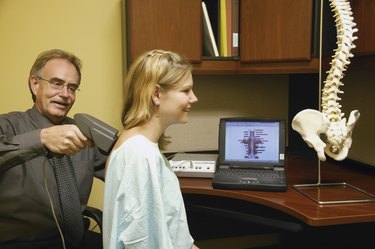
Inversion tables allow you to safely and easily hang upside down for partial or full inversion. Partial inversion, which takes you less than 90 degrees, will decompress your spine, according to Body Flex Sports Inc. Full inversion provides maximum stretching. Creating space between the vertebrae through decompression and stretching your muscles may make you taller. Inversion therapy also realigns your spine, improves posture and may improve conditions such as scoliosis and lordosis, according to SportsInjuryClinic.net. Oscillating on an inversion table increases blood flow and releases muscle tension. Combined, all these benefits can help your stand taller, straighter and at your maximum height.
Step 1
Adjust the height of the table so that it is 2 to 3 inches taller than you are. Look for a pin on the side of the frame that you can release so you can slide the foot assembly up or down for adjustment. Align the hole with the desired height and push in the height selector lock pin. Models will vary.
Video of the Day
Step 2
Place your back against the back rest pad and your feet through the rollers on the foot assembly. Secure your feet by moving the rollers as close together as you can. Pull out the pull pin, slide the top rollers down and replace the pin, or see your manual if your table does not have a pull pin.
Step 3
Adjust the safety strap underneath the back rest pad to the shortest length possible if you are a beginner. This will keep you from being able to accidentally invert more than you are ready for. Use trial and error to figure out the exact distance of the strap and the height setting as your height and weight will affect the ideal settings of the table for your body.
Step 4
Lie back on the machine and once you feel ready, raise one arm so the machine moves backwards to approximately 20 to 30 degrees. Remain relaxed in this position for a few minutes.
Step 5
Get off the machine and increase the angle to 60 degrees when you are ready. Lengthen the safety strap and get back on the table in the same position as before. Raise both arms to invert to 60 degrees.
Step 6
Lower and raise your arms alternatively to make the table oscillate. Perform gentle oscillations and inversion for a few minutes at a time, two to three times a day.
Tip
Eventually you will want to invert to 90 degrees if you have tense back, leg or spine muscles that are making your shorter.
Improving your posture and maintaining proper alignment of your spine will be better achieved by using the inversion table and performing correct posture exercises. Consult a physician, physical therapist or personal trainer for help developing a comprehensive program.
Warning
Always consult your doctor before inverting.
Inversion increases blood pressure.
There are many conditions that if you have mean you should not do inversion. These include, but are not limited to, pregnancy, high blood pressure, glaucoma, osteoporosis, obesity and cerbal sclerosis. You should not use an inversion table if you are taking anticoagulants, or have an ear infection, according to SportsInjuryClinic.net.
Video of the Day
Is this an emergency? If you are experiencing serious medical symptoms, please see the National Library of Medicine’s list of signs you need emergency medical attention or call 911.